Using Your RV’s Air Conditioning System While Driving
If you’re traveling in an RV during hot weather, you might wonder, can you run an RV air conditioner while driving? The good news is that it’s possible, but it depends on your RV’s power setup. While some RVs can run the AC using a generator, others may require an inverter or alternative cooling methods. In this guide, we’ll explore different ways to keep your RV cool on the road, power options for running the AC while driving, and expert tips for maximizing efficiency.
Can You Run Both Dashboard and Rooftop Air Conditioners?
Yes, you can run both the dashboard and rooftop air conditioners while driving your RV, but there are a few things to consider to make sure the systems work properly. The dashboard air conditioner is powered by your RV’s engine, while the rooftop air conditioner typically requires an external power source such as a generator or an RV’s shore power supply.
Dashboard Air Conditioning:
This system is always available while the engine is running. It is designed to cool the cabin as you drive, and it can provide enough cooling to keep the interior comfortable for short trips.
Rooftop Air Conditioning:
This requires additional power, which can be provided by an onboard generator, an inverter, or a battery pack. While the dashboard AC can handle basic cooling, the rooftop air conditioner is more effective in extremely hot climates or for longer trips.
Key Considerations:
- Ensure your generator has enough fuel to power the rooftop air conditioner if you plan on using it for an extended period.
- Make sure your power systems are robust enough to handle both air conditioners running simultaneously, particularly if you’re using other high-powered appliances (e.g., microwave, refrigerator).

How to Use Dashboard Air Conditioning While Driving
Using the dashboard air conditioner while driving your RV is relatively simple. The system operates much like the AC in a regular car, and you don’t need additional power sources like a generator. Here’s how you can optimize its performance:
1. Set the Temperature:
Adjust the temperature using the dashboard controls. Most dashboard AC units allow you to set the temperature to your desired comfort level. Set the temperature to “cool” mode for maximum efficiency.
2. Use Recirculated Air:
Activate the recirculation mode to prevent hot air from entering the cabin. This helps the AC cool the air more effectively without overworking the system.
3. Maximize Airflow:
Ensure your windows are properly closed, and the airflow vents are open to distribute cool air evenly throughout the cabin. Proper airflow will enhance the AC’s efficiency, helping to maintain a comfortable temperature without straining the system.
4. Maintain the System:
Regularly check and replace your cabin air filters to maintain optimal performance. Clean filters allow the AC to run more efficiently and prevent strain on the engine.

How to Use Rooftop Air Conditioning While Driving
Using rooftop air conditioning while driving your RV provides a powerful cooling solution, especially for larger RVs or in extremely hot climates. However, rooftop AC requires a power source, such as a generator, to run. Here’s how to use it safely:
1. Start the Generator:
To use the rooftop air conditioner, you’ll need to turn on the RV’s generator. Ensure that the generator is properly fueled and running before attempting to turn on the rooftop air conditioner. Most RV generators are designed to provide enough power to run multiple systems, including the air conditioner.
2. Monitor Power Consumption:
While your generator is running, monitor its power output to ensure it’s not overloading. You can use a power monitoring system in your RV to keep track of how much energy the AC and other appliances are consuming. This helps you avoid draining the generator too quickly.
3. Set the Thermostat:
Rooftop air conditioners typically come with a digital thermostat that allows you to set the temperature to your desired level. Set it to a comfortable range, typically between 70°F and 75°F for optimal cooling. Be sure to adjust the fan speed if necessary to improve airflow.
4. Shut Down Properly:
Once you reach your destination or no longer need the AC, turn off the rooftop air conditioner and the generator to conserve fuel and prevent overuse. It’s also important to allow the system to cool down before shutting it off.
5. Check for Airflow Blockages:
Before starting the RV’s journey, make sure the rooftop air conditioning unit is free of any obstructions such as branches, debris, or roof racks. These obstructions can reduce airflow and make the AC less effective.
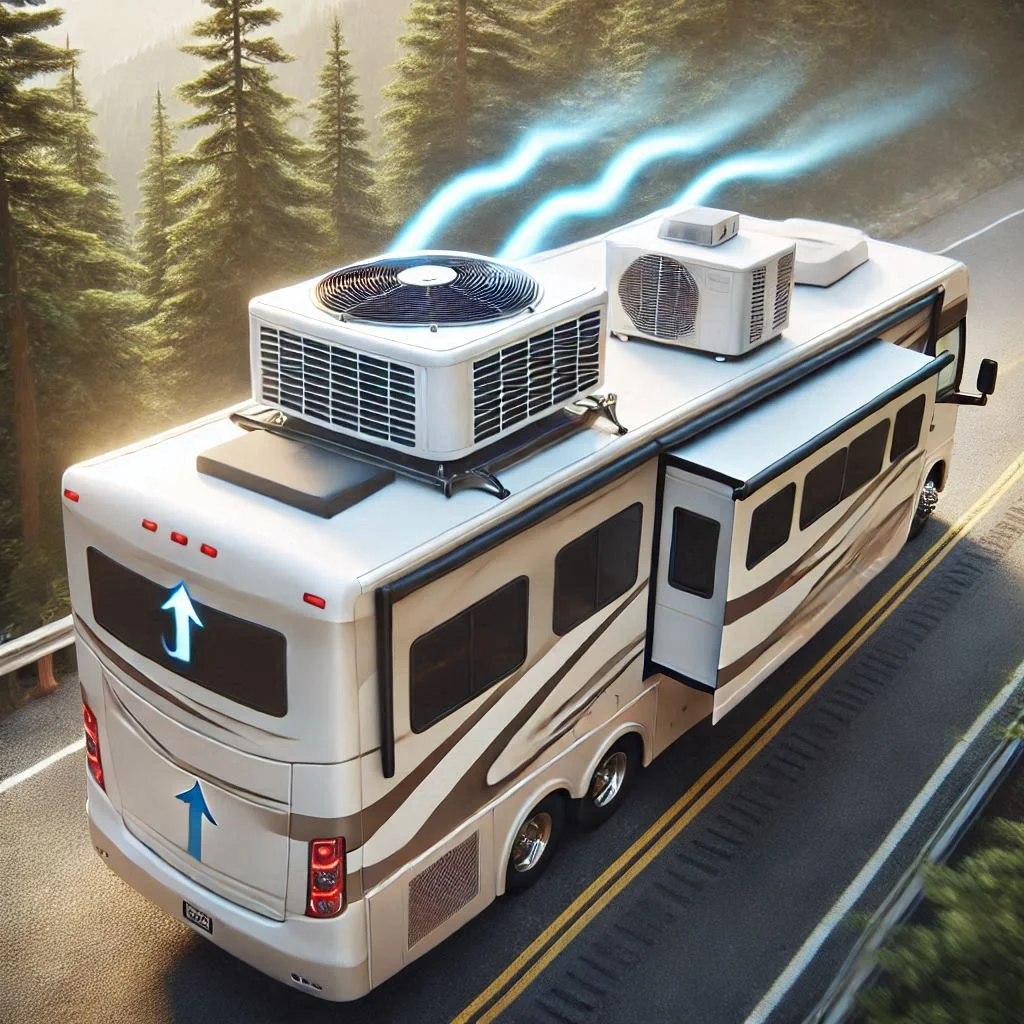
Is It Safe to Run Your RV’s Generator to Power the Air Conditioner While Driving?
Running your RV’s generator to power the air conditioner while driving is a convenient way to keep the interior cool during long trips. However, safety concerns arise when it comes to the operation of the generator while in motion. This section will explore the safety considerations, best practices, and potential impacts of running a generator during travel.
In general, it is safe to run your RV’s generator while driving, provided you follow specific safety guidelines. Your generator is designed to work while the RV is in motion, but there are crucial steps you must take to ensure safe operation, avoid damage to the generator, and prevent accidents.
Generator Safety Tips for RV Air Conditioning
Running a generator to power your RV’s air conditioning system is a reliable method, but safety must always be a priority. Here are essential tips to ensure your generator operates safely and efficiently while driving:
1. Ensure Proper Fuel Levels
Before starting your journey, check the fuel levels in both your RV’s tank and the generator. Running low on fuel can cause the generator to stop unexpectedly, leading to a loss of power to the air conditioning and potentially causing damage to the generator itself. Always keep a full tank or a backup fuel supply when traveling long distances.
2. Monitor Generator Load
Running multiple appliances on your generator can cause it to overload, especially when trying to power the air conditioner. Ensure that the total load on the generator does not exceed its rated capacity. Use a power monitor to track the load in real-time and avoid overburdening the system.
3. Keep the Generator Ventilated
Generators need proper ventilation to prevent overheating. Ensure that your generator has enough space and airflow for exhaust gases to escape. Never run the generator in a confined space, as the risk of carbon monoxide buildup can be deadly. Position the RV so that the exhaust is directed away from the vehicle.
4. Use a Generator with Sufficient Power
Choose a generator that has the capacity to power your air conditioner along with other essential RV appliances. For a typical RV air conditioner, a generator with at least a 3,500-watt rating is recommended. Check the specifications of both your RV air conditioner and the generator to ensure they are compatible.
5. Check for Fuel Leaks and Maintenance
Before starting your journey, inspect the generator for any fuel leaks or other maintenance issues. A well-maintained generator is less likely to malfunction and can run smoothly for longer periods. Regular maintenance, such as changing the oil and cleaning the air filter, will also help improve the generator’s efficiency.

Impact of Running a Generator While Driving
Running a generator while driving is an effective way to keep your RV’s air conditioning system functioning, but it can have several impacts on both the generator and the RV. Understanding these impacts will help you make informed decisions to optimize your RV’s performance and avoid issues while on the road.
1. Fuel Consumption
Running a generator while driving will increase fuel consumption, as the generator needs fuel to operate. Depending on the load, the generator may consume up to 1-2 gallons of fuel per hour. This can significantly reduce your RV’s fuel efficiency, especially if you’re driving for long periods with the air conditioning running. Plan your fuel stops accordingly and ensure that your generator isn’t overworking.
2. Generator Noise
While modern generators are designed to be quieter than older models, they still produce noise that can become distracting, especially at high speeds. Prolonged exposure to the noise can also lead to hearing fatigue, especially during extended trips. If noise is a concern, consider using a quieter, inverter-style generator or adding soundproofing materials to reduce noise levels.
3. Engine Strain
When running a generator while driving, your RV’s engine and electrical system are under additional strain. If the generator is pulling too much power or if the RV’s engine is underpowered, it may result in slower acceleration or engine overheating. Always monitor the load on the engine and generator to ensure that neither is being overworked.
4. Air Conditioning Efficiency
Using a generator to power the air conditioner might not be as efficient as running it on shore power. The generator’s performance can vary depending on the load, fuel levels, and outside temperature. Make sure the generator is properly sized for your air conditioner to ensure optimal cooling.
5. Environmental Impact
Running a generator produces carbon emissions, contributing to air pollution. Be mindful of this impact and minimize generator usage when possible, such as by using alternative cooling methods (e.g., opening windows or using battery-powered fans) during short trips.
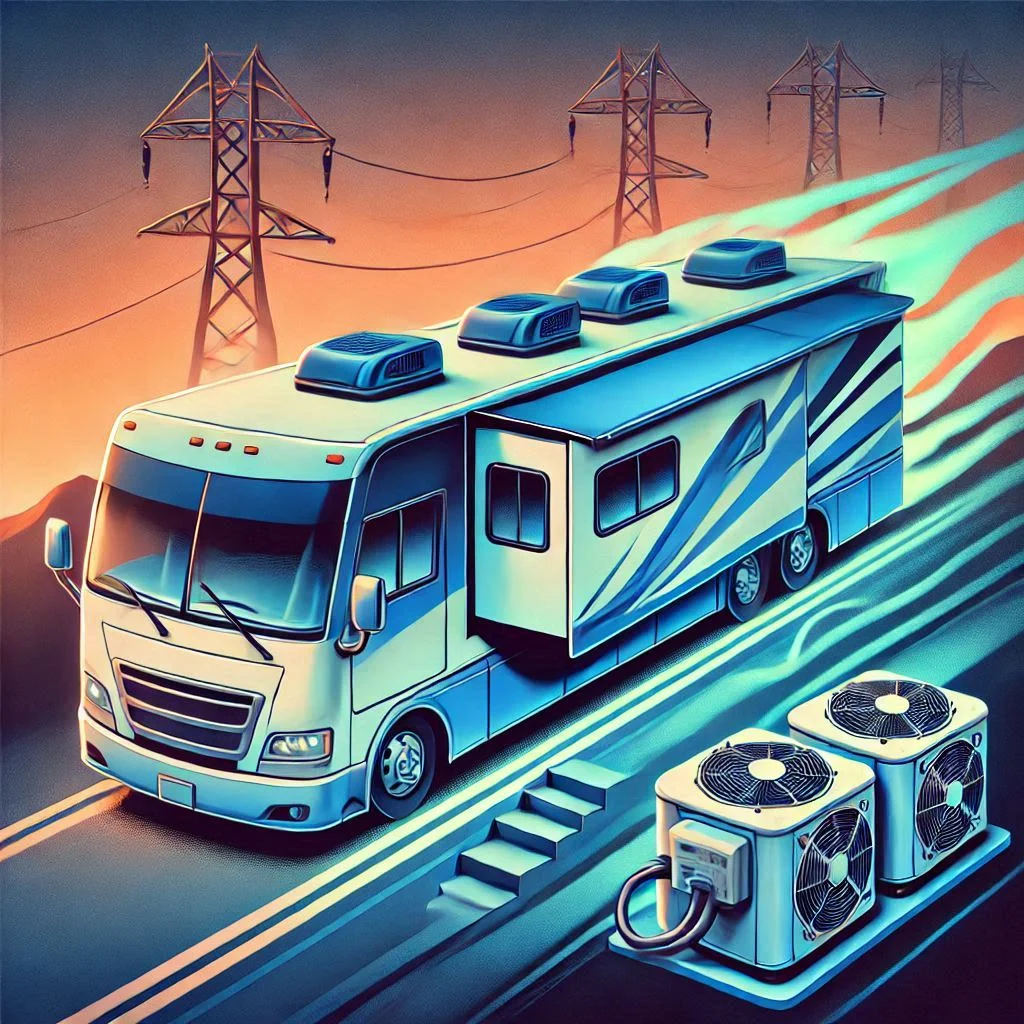
Alternatives to Rooftop Air Conditioning While Driving
While a rooftop air conditioning unit is a powerful way to cool your RV during long trips, it isn’t always the most energy-efficient or feasible option, especially when driving. Fortunately, several alternatives can keep your RV cool without relying on the rooftop AC. These methods offer flexible cooling solutions, often with lower power consumption and fewer maintenance requirements.
Here, we will explore a variety of alternatives that can keep your RV comfortable and cool while you’re on the road, without the need for rooftop air conditioning.
Run the Air Conditioner Before You Leave
One of the easiest and most effective ways to ensure a cool RV interior while driving is to run the air conditioner before you leave. This method helps cool down the RV’s interior temperature, allowing the air conditioner to work at its peak efficiency without running it while driving.
How to Maximize Cooling Efficiency:
- Pre-cool the RV: Before hitting the road, allow your RV’s air conditioning to run for 30 to 45 minutes, depending on the outside temperature. This will lower the internal temperature, so it remains comfortable even after the air conditioner is turned off.
- Plan Your Departure: Consider leaving early in the morning or later in the evening when temperatures are cooler. This helps extend the time before the inside temperature starts to rise again, reducing the need for frequent cooling while driving.
- Use Ventilation: Once you start driving, keep windows closed and vents open to prevent warm air from entering the RV. The cooling effect will last longer if air circulation is kept minimal.

Use Battery-Powered Fans for Extra Coolness
If you prefer not to run your RV’s air conditioning continuously while driving, battery-powered fans are an excellent alternative to provide additional cooling and air circulation. These fans are portable, energy-efficient, and can be placed strategically around your RV to enhance airflow.
Benefits of Battery-Powered Fans:
- Low Power Consumption: Battery-powered fans consume significantly less power than an air conditioning unit, extending your battery life and reducing the load on your generator.
- Portability and Flexibility: These fans can be moved around to target specific areas, providing cool air exactly where it’s needed most, whether in the cabin, bedroom, or kitchen.
- Quiet Operation: Unlike a generator or rooftop air conditioner, battery-powered fans are generally quieter, making them ideal for peaceful travel.
How to Use:
- Place the fan near windows or open spaces to promote air circulation.
- Consider using a fan with multiple speed settings for customized cooling.
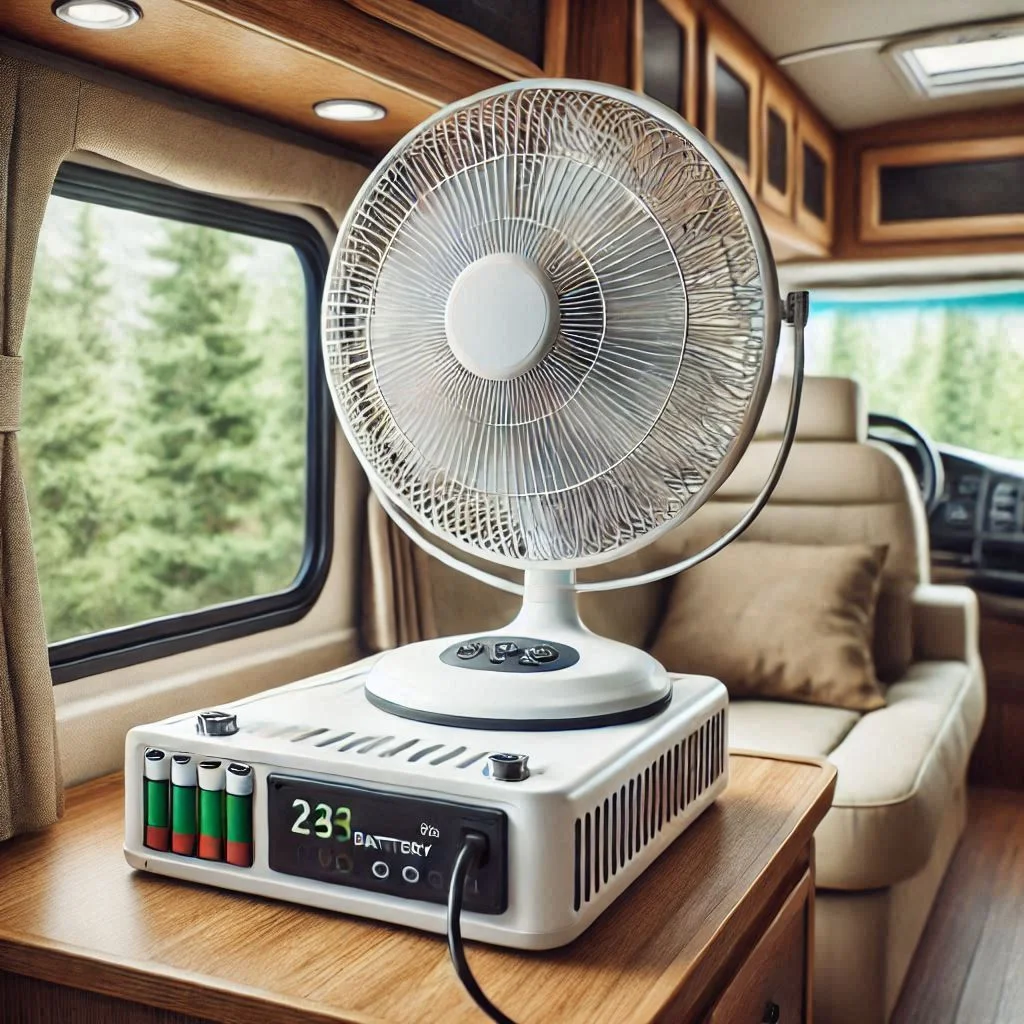
Invest in Window Tinting & Use Window Coverings for Shade
Window tinting and coverings are highly effective ways to keep your RV cooler during travel by blocking out the sun’s harsh rays. These alternatives can reduce the internal temperature and minimize the need for air conditioning while on the road.
Window Tinting:
- UV Protection: Window tinting reduces UV radiation from the sun, which is a primary contributor to interior heat. The tint also helps protect your furniture and upholstery from fading due to sun exposure.
- Privacy & Comfort: Tinting your windows improves privacy inside the RV, especially when parked, and reduces glare for a more comfortable driving experience.
Window Coverings:
- Shades or Curtains: Using reflective shades or thick curtains to cover windows blocks sunlight and prevents heat buildup. You can install these coverings on side windows, skylights, or even the windshield for maximum shade.
- Reflective Sunshades: These are particularly useful for windshields and large windows, reflecting sunlight away from the RV’s interior, keeping it cool during the day.

Open a Window to Improve Air Circulation
Opening a window while driving your RV can improve air circulation, especially when combined with other cooling methods. By allowing fresh air to enter, you can create a natural breeze that helps reduce the buildup of heat.
Tips for Improving Air Circulation:
- Strategic Window Placement: Open windows on opposite sides of the RV to allow for cross-ventilation. This creates a natural flow of air that helps reduce the interior temperature.
- Control Dust & Noise: Keep the windows closed while driving through dusty or noisy areas. Once you’re on open roads, you can open them to allow fresh air in.
- Combination with Fans: Opening the windows in combination with battery-powered fans can significantly improve the effectiveness of natural airflow.
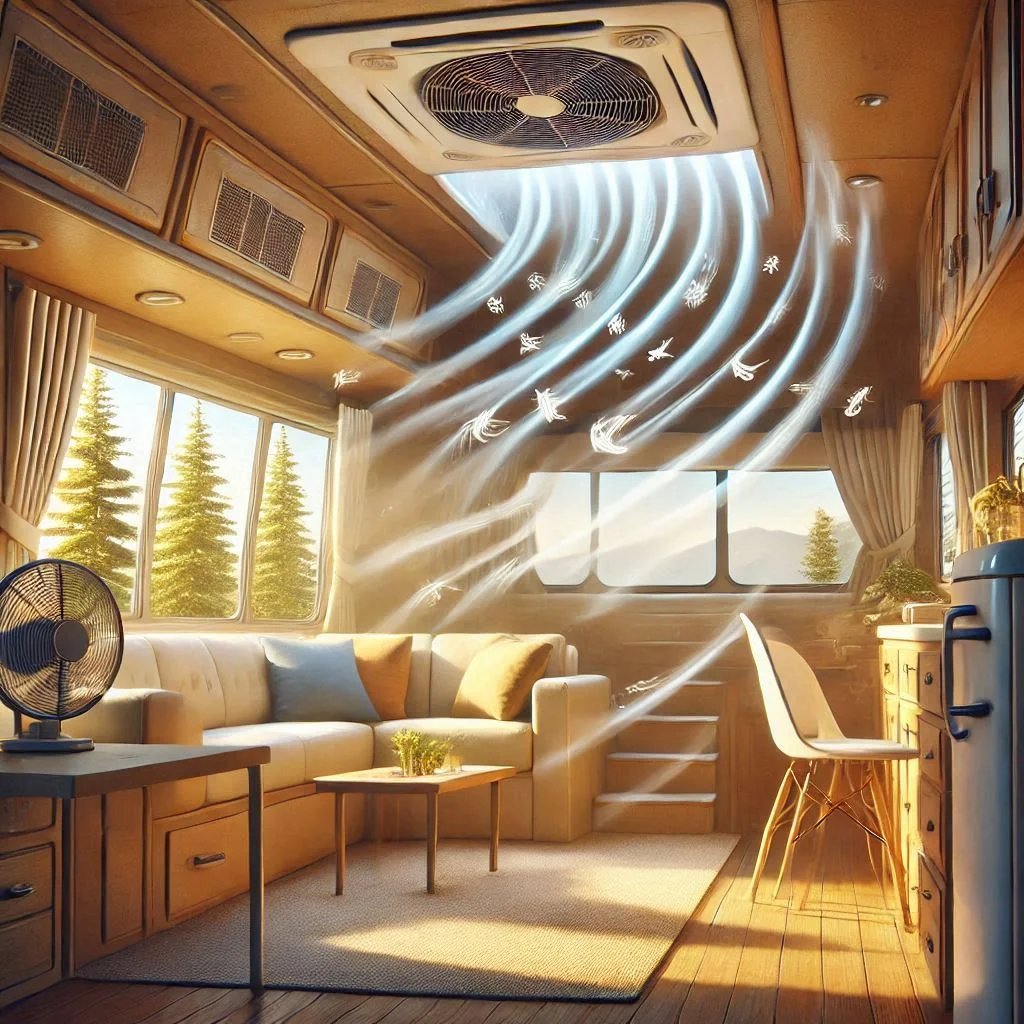
Use a Portable AC Unit While Driving
If you’re looking for a more powerful alternative to rooftop air conditioning without the need for a large generator, a portable AC unit can be a great option. These units are designed to cool smaller spaces and can be moved around easily.
Advantages of a Portable AC Unit:
- Compact and Lightweight: Portable air conditioners are easy to store and transport, making them ideal for RVs with limited space.
- Flexible Placement: You can place the portable AC unit wherever you need it most, whether in the living area, bedroom, or kitchen.
- Energy Efficiency: While portable AC units consume more power than fans, they are generally more energy-efficient than rooftop air conditioning units, particularly for smaller RVs.
Considerations:
- Power Source: Portable AC units typically require access to a power source, such as a generator or an inverter, to operate.
- Ventilation: Make sure the unit has proper venting to expel hot air outside the RV.
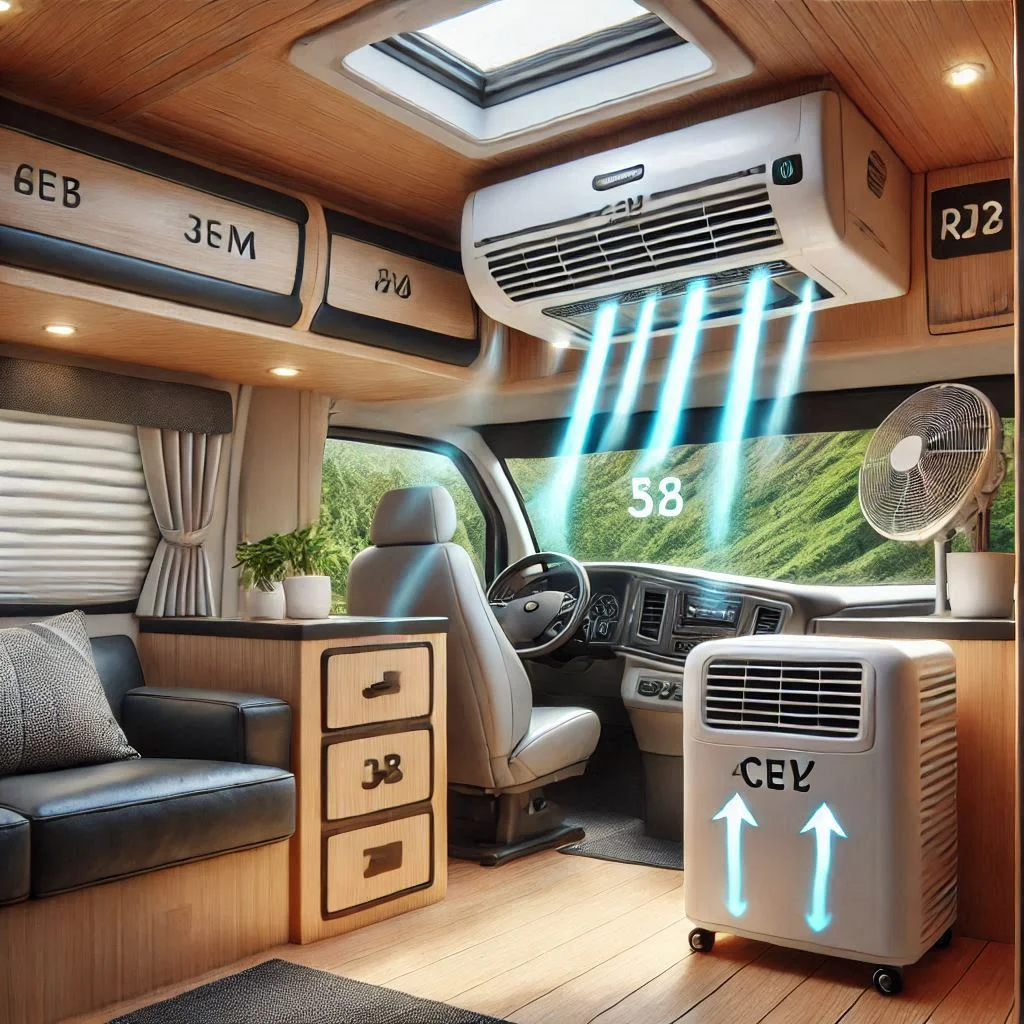
Key Rules for Using an RV Air Conditioner
An RV air conditioner is a vital component for staying cool during summer road trips or extended stays in hot climates. However, understanding the key rules for using your RV air conditioner is crucial to ensure safe operation, efficiency, and longevity. This section will guide you through essential aspects of powering your RV AC unit, including power requirements, generator compatibility, and energy consumption.
Can You Run an RV Air Conditioner on 30-amp or 15-amp Power?
When operating an RV air conditioner, power requirements are one of the most important factors to consider. RV air conditioners typically require a substantial amount of electricity, and understanding how to power them is essential for smooth operation.
Using 30-amp Power:
- Standard Power Supply for Most RVs: Many RVs are equipped with a 30-amp power supply, which is commonly used to run various electrical systems, including the air conditioner. A 30-amp circuit can generally handle the load of a standard RV air conditioner.
- Air Conditioner Compatibility: Most standard RV air conditioners require approximately 13.5 to 15 amps of power, which fits within the 30-amp capacity, leaving room for other appliances to run simultaneously.
- Energy Management Tips: To avoid overloading your RV’s electrical system, manage your power consumption wisely, turning off high-energy appliances while the air conditioner is running.
Using 15-amp Power:
- Limited Power for Air Conditioners: Running an RV air conditioner on a 15-amp circuit is not recommended unless you’re using a smaller or more energy-efficient model. 15-amp circuits typically do not have the capacity to handle the surge of power required by an air conditioner at startup.
- Safety Concerns: Using a 15-amp circuit to run an air conditioner can lead to tripped circuit breakers, overheating, or even damage to your electrical system. If you must use a 15-amp circuit, it’s essential to use an air conditioner with a lower wattage and manage your overall energy consumption carefully.
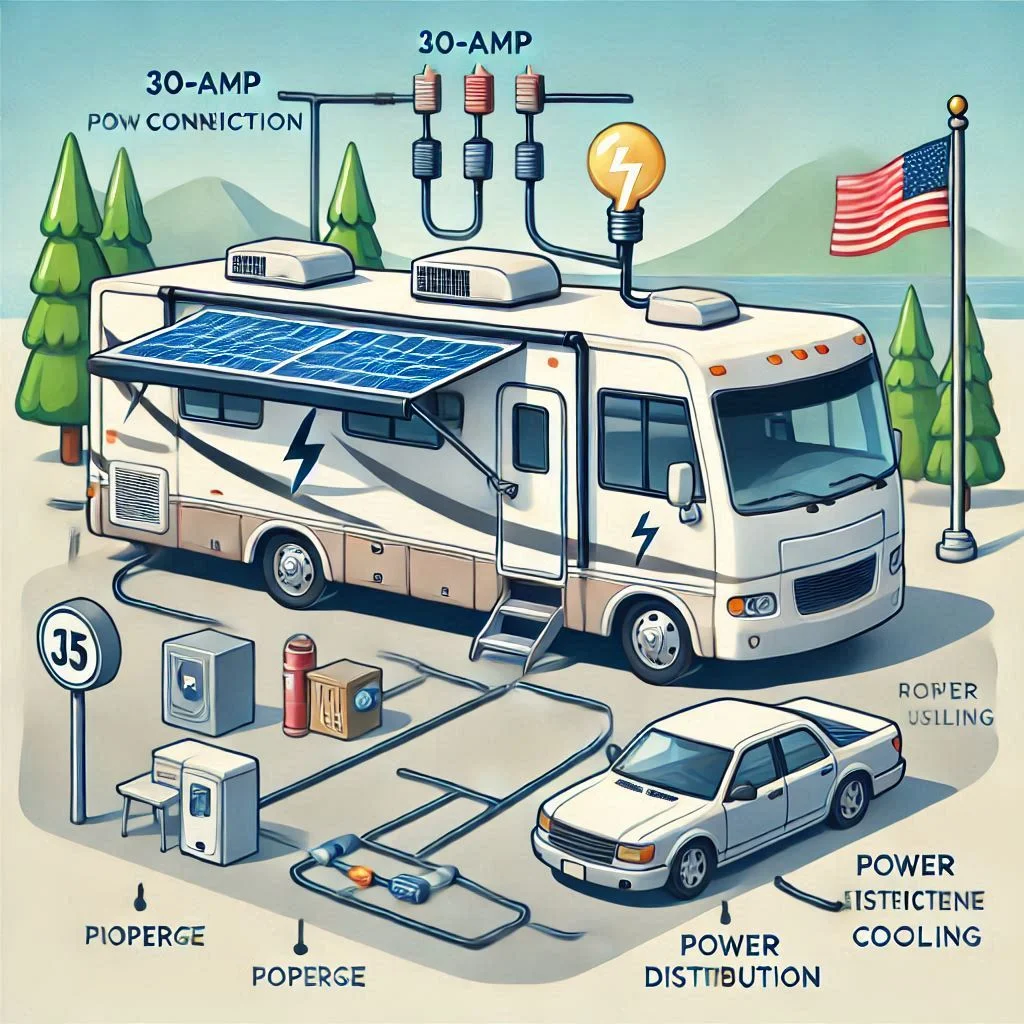
Can You Use a 120V Power Source for Your RV Air Conditioner?
Many RV air conditioners are designed to run off a 120V power supply, commonly available at campgrounds or through a generator. Understanding whether a 120V power source is sufficient for your air conditioner is essential for its proper functioning.
Using a 120V Power Supply:
- Most Common Power Option: Many RVs are designed to plug into standard 120V power outlets at campgrounds. This voltage is adequate to power most RV air conditioners, but it’s important to ensure that the electrical connection can support the unit’s power requirements.
- Power Demand of Air Conditioners: A typical RV air conditioner may require anywhere from 1,000 to 1,500 watts to operate efficiently. If you plan to use a 120V outlet, ensure that your power source can handle these demands, especially if other appliances are being used simultaneously.
- Check Power Rating: Always check your air conditioner’s power rating (listed in amps or watts) to determine if a 120V power source will be sufficient. Overloading the circuit can result in tripped breakers or a blown fuse.
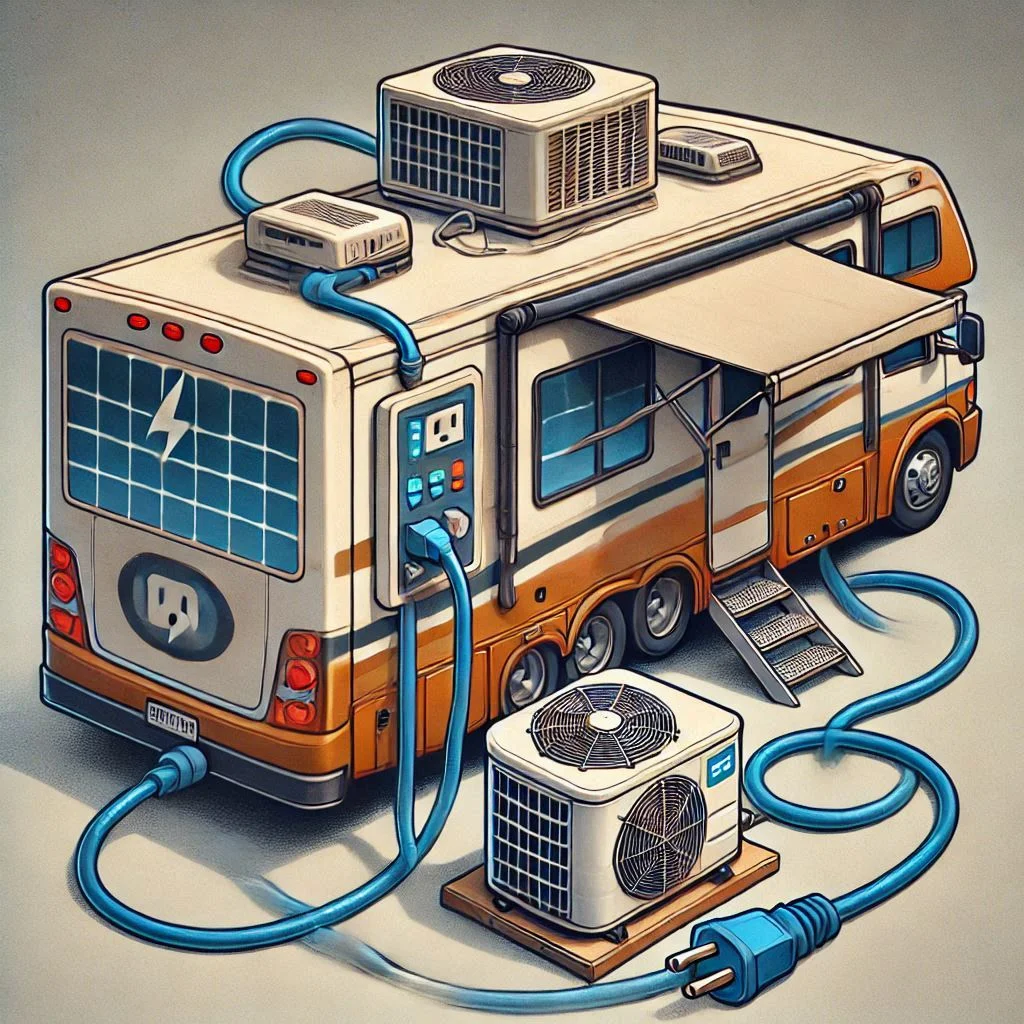
How Many Amps and Watts Does an RV Air Conditioner Use?
Knowing how many amps and watts your RV air conditioner uses is crucial for managing your RV’s electrical system effectively. The amperage and wattage ratings help you assess your power needs and avoid overloading your circuits.
Typical Power Usage of an RV Air Conditioner:
- Amps: A standard RV air conditioner uses approximately 12 to 16 amps of power, with larger units using up to 20 amps, especially when running at full capacity. It’s important to ensure that your electrical system can handle the load without tripping breakers.
- Watts: RV air conditioners typically consume between 1,000 to 1,500 watts while running, with higher-end models using up to 2,000 watts. This power consumption can vary depending on the model, the temperature outside, and whether you’re running other electrical devices simultaneously.
- Consider Surge Watts: Keep in mind that RV air conditioners require a higher surge wattage during startup, sometimes as much as 2-3 times their running wattage. This surge should be considered when choosing a generator or power source.
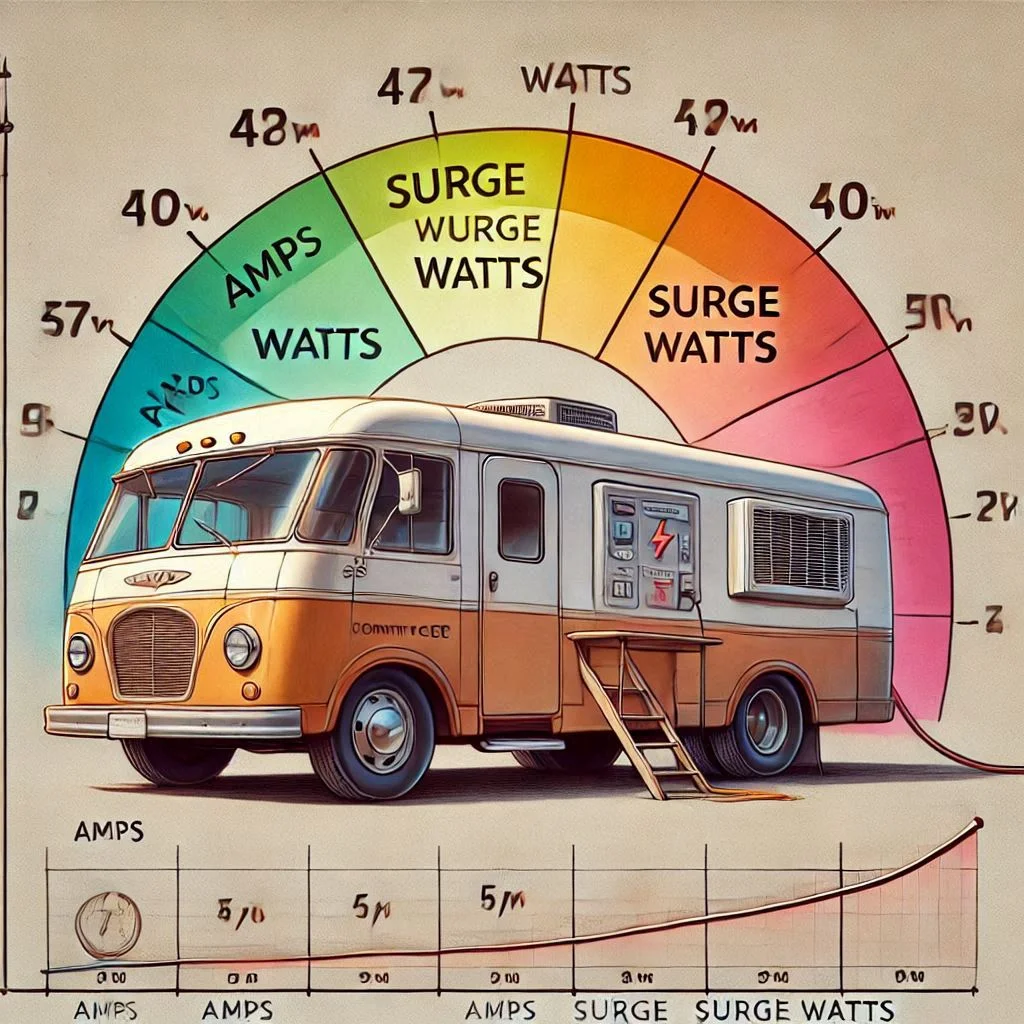
Will a 3500-watt Generator Run an RV Air Conditioner?
Many RV owners rely on generators to power their air conditioners when boondocking or when a campground does not provide adequate electrical service. A 3500-watt generator is one of the most common choices, but can it handle the load of an RV air conditioner?
Generator Power Requirements:
- Adequate for Most Standard Air Conditioners: A 3500-watt generator can typically handle the power requirements of a standard RV air conditioner, as well as other appliances running simultaneously. This wattage is sufficient to start most RV air conditioners and keep them running smoothly.
- Consider Startup Surge: Remember that RV air conditioners require a surge of power when they start, which can be up to 3 times their running wattage. A 3500-watt generator should be able to handle this surge, but it’s important to check the surge rating of both your air conditioner and the generator to ensure compatibility.
- Power Management: If you’re using a 3500-watt generator to power other appliances alongside the air conditioner, make sure the total wattage does not exceed the generator’s capacity. Excessive load can cause the generator to stall or shut down.
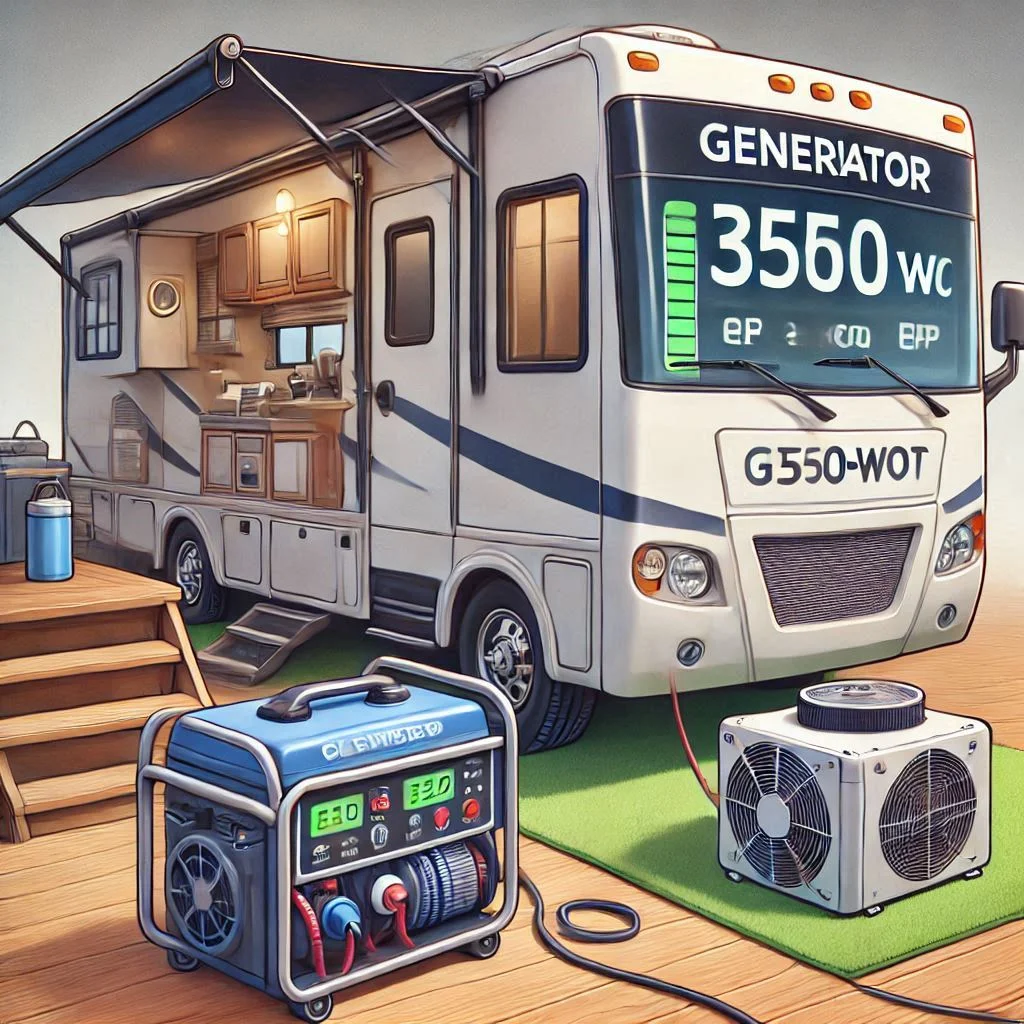
How to Maintain Your RV Air Conditioner
Maintaining your RV air conditioner is crucial for ensuring its longevity, optimal performance, and energy efficiency. Regular upkeep prevents costly repairs and helps you stay comfortable during your travels. Below are the essential maintenance steps and best practices to keep your RV air conditioner running smoothly.
How to Clean the RV Air Conditioner Filter
The filter is one of the most important components of your RV air conditioner. It helps trap dirt, dust, and debris from the air, allowing the system to work efficiently. Over time, however, filters can become clogged, leading to reduced airflow, increased energy consumption, and potential damage to your system.
Steps for Cleaning the RV Air Conditioner Filter:
- Turn off the AC and Power Supply:
Before you begin, ensure that the air conditioner is turned off and the power supply is disconnected to prevent any electrical hazards. - Locate and Remove the Filter:
Most RV air conditioners have a filter that can be accessed through the ceiling vent. Open the vent and carefully remove the filter. Depending on the model, the filter may slide out or require unscrewing. - Inspect the Filter:
Before cleaning, inspect the filter for any noticeable damage or excessive buildup. If the filter is severely damaged or worn out, it’s best to replace it with a new one. - Clean the Filter:
- Vacuuming: Use a vacuum cleaner with a brush attachment to remove loose dust and debris from the filter.
- Washing: If the filter is washable, rinse it under lukewarm water to remove any stubborn dirt. For more thorough cleaning, use a mild detergent or soap. Avoid harsh chemicals that can damage the filter.
- Dry the Filter: Allow the filter to air dry completely before reinstalling it. Never use a hairdryer or other heat sources, as this could warp or damage the filter.
- Reinstall the Filter:
Once the filter is dry, carefully reinstall it back into the air conditioner unit. Ensure it’s securely in place to avoid any issues with airflow.
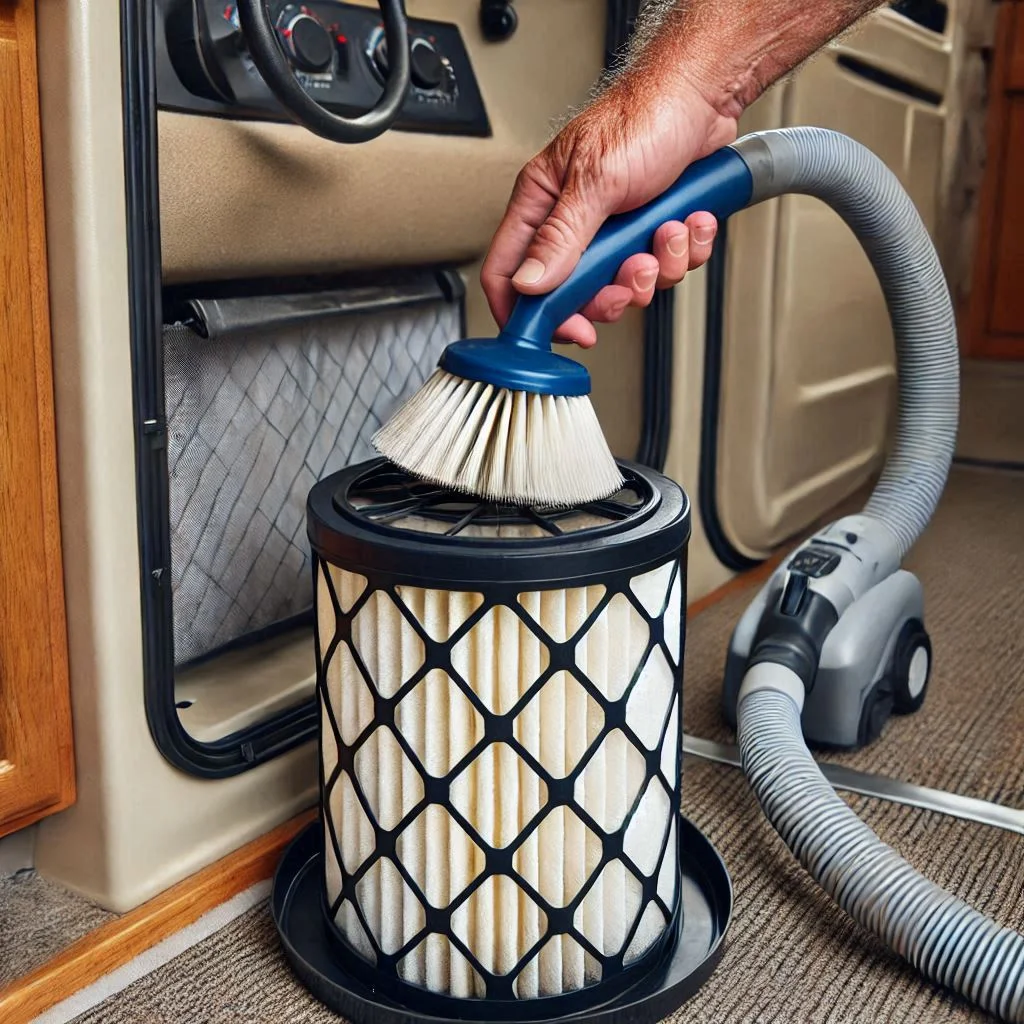
Tips for Safe Air Conditioner Usage
Using your RV air conditioner safely ensures its longevity and your safety while on the road. By following some simple guidelines, you can prevent common issues and avoid putting unnecessary strain on your system.
1. Avoid Overloading the System:
Ensure that the air conditioner is not overloaded with too many tasks. Running multiple high-energy appliances (such as a microwave or space heater) at the same time as your air conditioner can cause the system to struggle and increase the risk of malfunction. Prioritize cooling the RV and turn off non-essential appliances.
2. Monitor Power Supply:
Always check your power source’s capabilities before using the air conditioner. Whether you’re connected to a campground’s 120V outlet, using a generator, or running off batteries, make sure the power supply can handle the air conditioner’s power requirements without overloading.
3. Turn Off When Not in Use:
Turning off the air conditioner when you’re not in the RV helps prevent wear and tear. It also saves energy and extends the lifespan of the unit. This is especially important when you’re parked and not using the RV for long periods.
4. Keep Vents and Ducts Clear:
Ensure that vents and ducts are free from blockages, including furniture or other items that could obstruct airflow. Proper airflow is essential for the AC to function efficiently and to prevent overheating.
5. Prevent Water Damage:
Some RV air conditioners may accumulate water during operation. Regularly check the drainage system to ensure it’s working correctly. If you notice water pooling near the unit or inside the RV, investigate and clear any blockages in the drainage lines.
6. Regularly Inspect the Air Conditioner:
Performing periodic inspections of your RV’s air conditioner can prevent issues before they become major problems. Look for signs of wear, such as leaks, rust, or corrosion, and get them fixed promptly.
7. Clean the Coils and Condenser:
In addition to the filter, the coils and condenser should be cleaned at least once a year. Dirt and debris can build up on these parts, reducing the system’s efficiency and causing it to overheat. Use a soft brush or coil cleaner to gently remove dirt from the coils.

The Top Questions About RV Air Conditioners
When it comes to RV air conditioners, many RV owners have specific questions regarding usage, efficiency, and functionality. To ensure that your air conditioner operates at its best, understanding these common queries can help you make informed decisions. Below are answers to some of the most frequently asked questions about RV air conditioners.
How Long Can You Run an RV Air Conditioner?
The duration you can run an RV air conditioner largely depends on the power source and the unit’s energy requirements. Generally, RV air conditioners are designed to run continuously for long periods, but it’s important to ensure your power source is capable of supporting the load.
Factors that affect runtime:
- Power Source: If you’re plugged into shore power, you can run the AC for as long as needed. However, if you rely on a generator or battery, your runtime will be limited based on the power capacity. For example, a typical 13,500 BTU RV air conditioner can run for about 4-6 hours on a 3,500-watt generator before depleting the fuel supply.
- Ambient Temperature: Running the AC in very hot conditions may cause the unit to work harder, which can lead to a higher energy demand and a reduction in runtime.
- Energy Efficiency: Newer, energy-efficient RV air conditioners tend to consume less power, allowing for longer running times without overloading the power source.
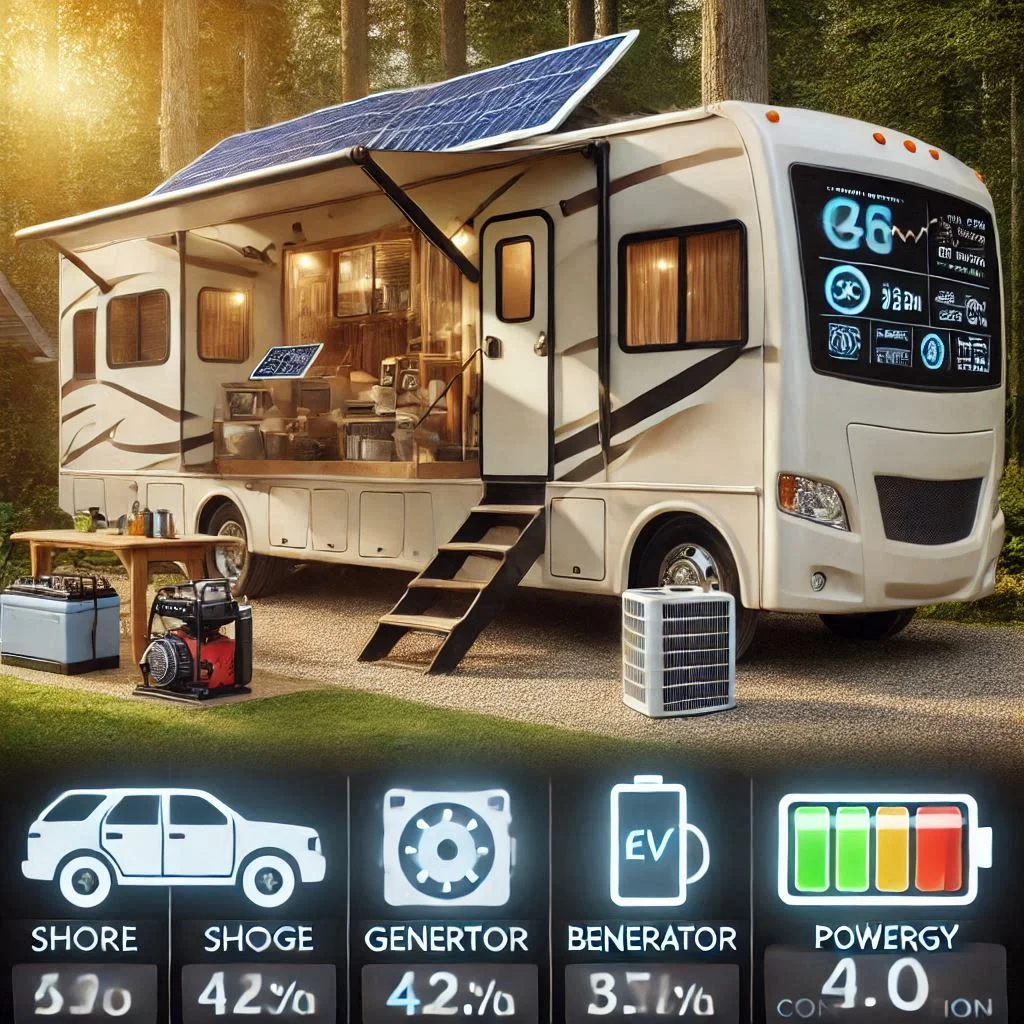
How to Make Your RV Air Conditioner Colder
Sometimes, your RV air conditioner may not be cooling as effectively as you’d like. If this happens, there are several ways to improve its performance and make the air colder.
Tips to increase cooling efficiency:
- Adjust the Thermostat: Ensure your thermostat is set to the optimal cooling temperature. Lowering the temperature gradually rather than drastically can prevent the unit from overworking.
- Keep Vents Open: Make sure that all air vents are open and unobstructed, as closed vents can restrict airflow and reduce cooling efficiency.
- Use Window Covers: Install window coverings or use reflective window tint to block out the sun and keep the inside cooler. This will reduce the load on the air conditioner and make it more effective.
- Add Insulation: Insulating your RV can help maintain a lower interior temperature. Insulation improves the efficiency of the AC unit by reducing heat intake.
- Ensure Proper Ventilation: Regularly clean and maintain the air conditioner’s filters and coils to ensure that it’s functioning at maximum efficiency.
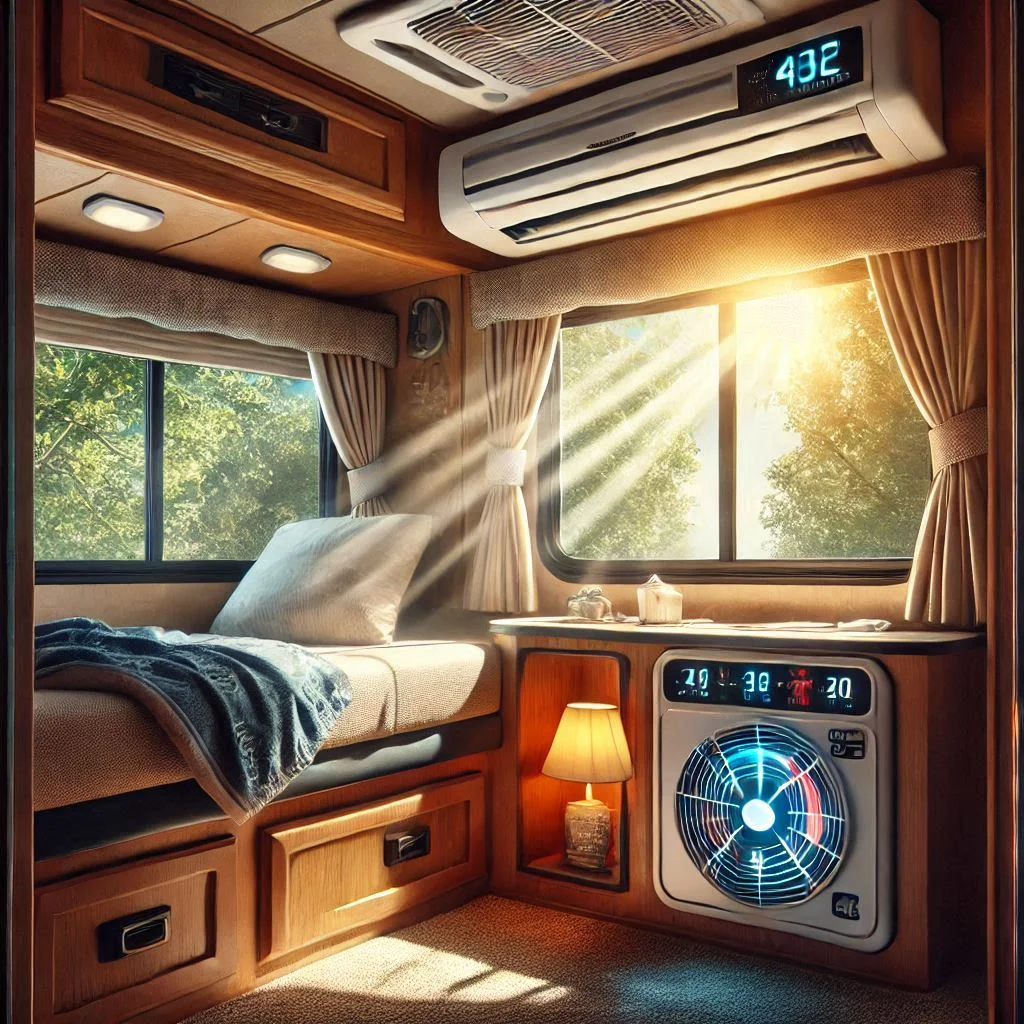
What Is the Smallest RV Air Conditioner?
The smallest RV air conditioners typically have a lower BTU rating, making them ideal for smaller RVs or minimal cooling requirements. The smallest options on the market are typically 5,000 to 8,000 BTUs, designed for smaller rigs or areas where space and power are limited.
Key Features:
- Compact Size: These smaller units are lightweight and easy to install, especially for those with limited space in their RVs.
- Energy Efficiency: Though they have a lower cooling capacity, smaller units tend to be more energy-efficient, which is ideal for off-grid RVing.
- Application: Smaller units are ideal for cooler climates or for use in combination with other cooling methods, such as fans or portable AC units.
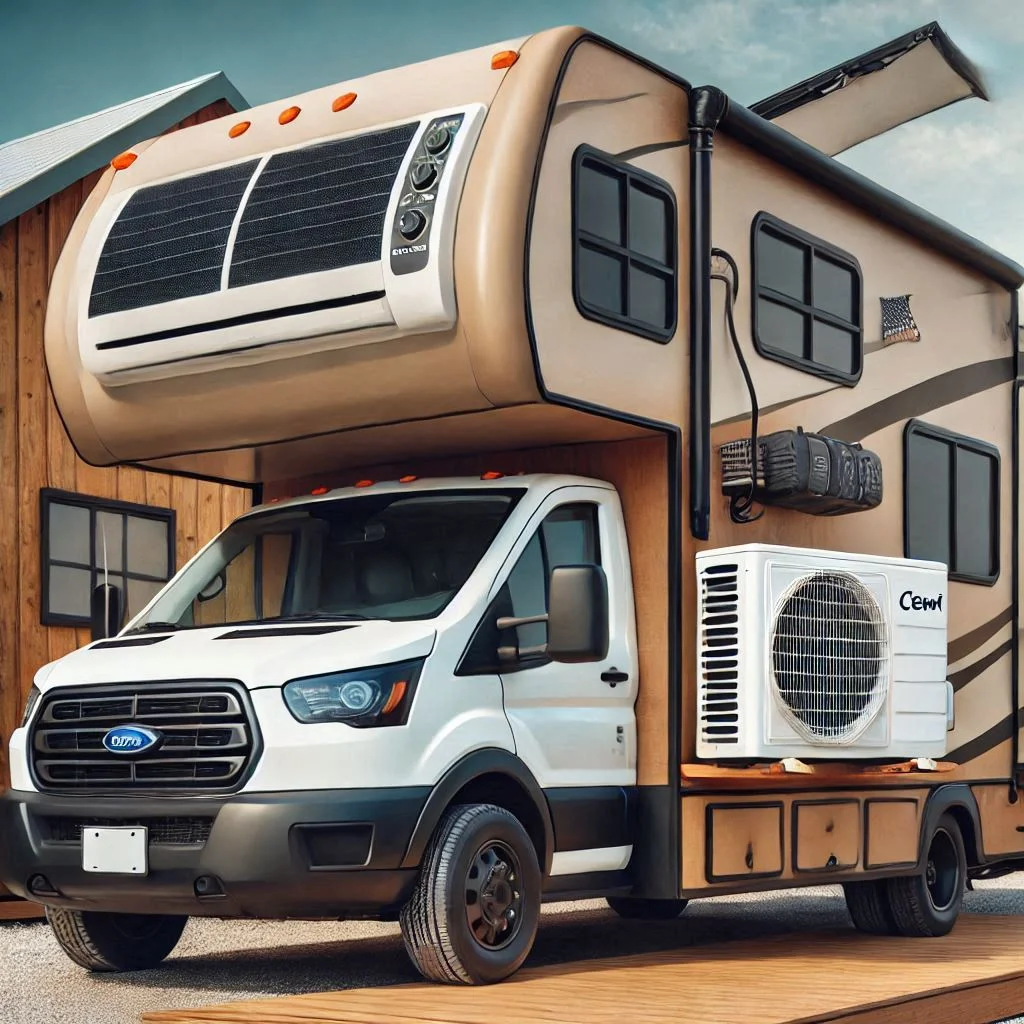
Can You Add a Thermostat to an RV Air Conditioner?
Yes, you can add a thermostat to most RV air conditioners to improve temperature control and energy efficiency. A thermostat allows you to set a specific temperature, so the air conditioner runs only as needed, saving energy and keeping the interior comfortable.
Installation and Benefits:
- Simple Installation: Most RV air conditioners are compatible with external digital thermostats. The installation process is relatively straightforward and can be done by a professional or as a DIY project.
- Energy Savings: By using a thermostat, you prevent the air conditioner from running continuously, as it will automatically turn off when the desired temperature is reached and turn back on when the temperature rises.
- Improved Comfort: A thermostat helps maintain a consistent temperature inside your RV, preventing fluctuations and ensuring comfort.
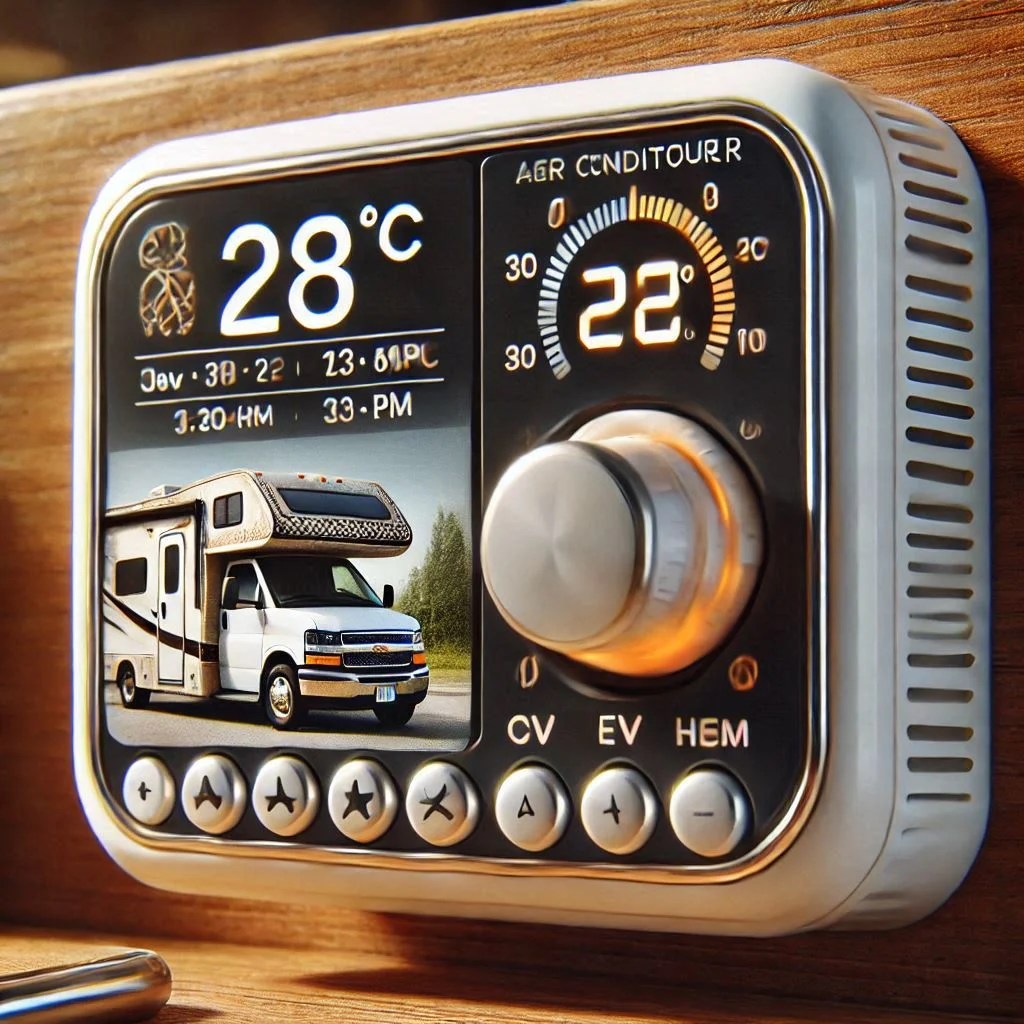
Does RV Height Include the Air Conditioner?
Yes, when measuring the height of an RV, the air conditioner is included in the overall height. RV manufacturers include the air conditioner in the specified height measurement, as it’s an integral part of the vehicle.
Why is this important?
- Low Bridges & Overhangs: If you’re traveling under low bridges or overhangs, knowing the total height of your RV, including the air conditioner, is crucial to avoid hitting obstacles.
- Storage Considerations: When parking or storing your RV, the total height with the air conditioner should be factored in to ensure clearance in parking garages or other storage areas.

Is It Legal to Run an RV Refrigerator While Driving?
Yes, it is legal to run your RV refrigerator while driving, provided that it is properly connected to a power source. Most RV refrigerators can run on 12V DC power, which is typically supplied by your RV’s battery system while the vehicle is in motion.
Key Considerations:
- Power Source: Ensure that your RV’s battery is adequately charged or that your vehicle’s alternator is providing sufficient power for both the fridge and other essential systems.
- Fuel Efficiency: While running your RV fridge on 12V power, be mindful that it may increase the power draw on your RV’s battery. To reduce fuel consumption, you can switch the fridge to propane if available.
- Safety: Always make sure the fridge is properly secured during transit to prevent any items from causing damage inside the unit.
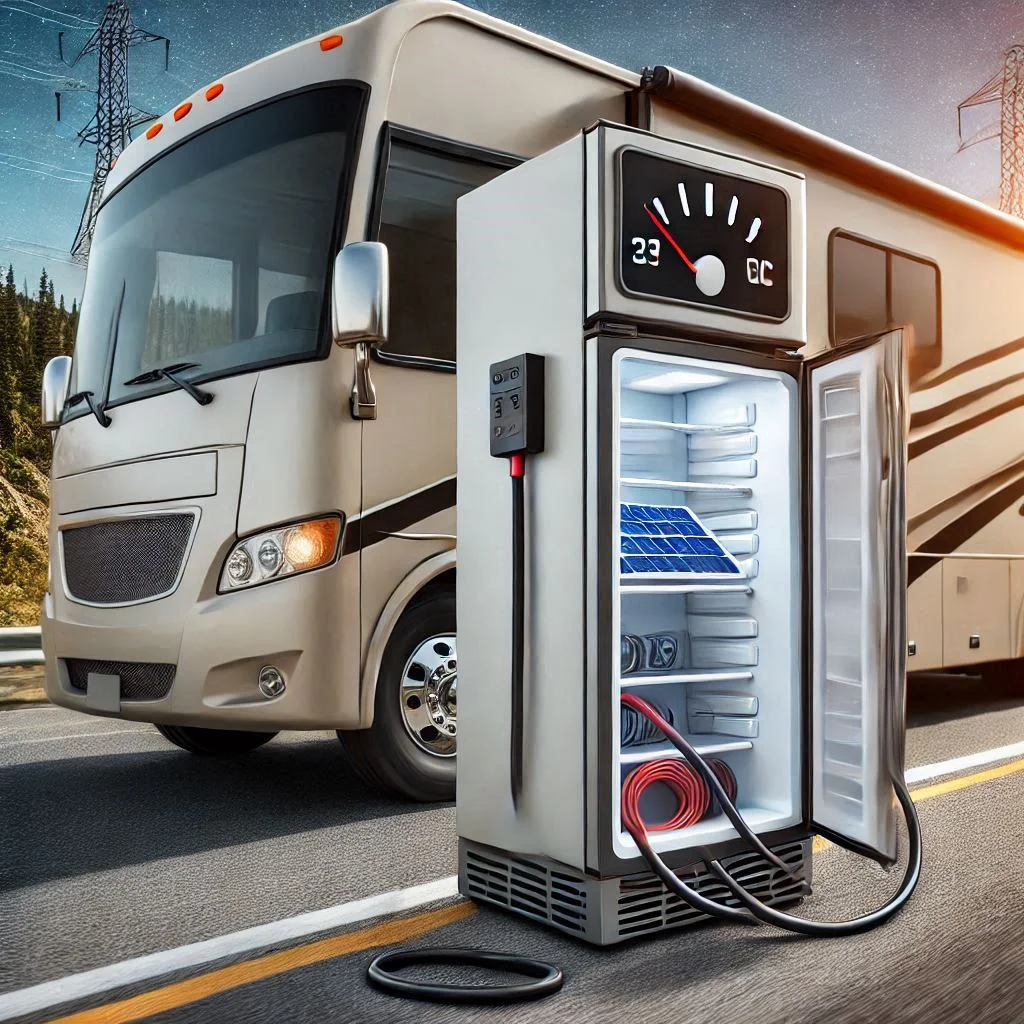
FAQs: Can You Run an RV Air Conditioner While Driving?
If you’re planning a long road trip or journey in your RV, keeping your RV cool is a priority, especially during hot weather. Many RV owners have questions about how to use their air conditioner while on the road. Below are answers to the most frequently asked questions about running an RV air conditioner while driving.
Q1: Can you run an RV air conditioner while driving?
A1: Yes, you can run an RV air conditioner while driving, but it depends on your power source. If your RV has a generator, you can use it to power the rooftop air conditioner. For dashboard air conditioning, your RV’s engine power typically runs it without the need for external power. However, if you’re relying on a generator to run the rooftop air conditioner, it’s important to ensure the generator is in good working condition and is safely operating without interfering with vehicle operation.
Q2: Can I use both the dashboard and rooftop air conditioner while driving my RV?
A2: Yes, you can use both the dashboard air conditioner and the rooftop air conditioner while driving. These systems operate independently. The dashboard AC is powered by your RV’s engine, while the rooftop air conditioner requires an external power source, typically a generator or a shore power connection. Be mindful of your power capacity to ensure that your battery or generator is not overloaded, especially when both air conditioners are running at the same time.
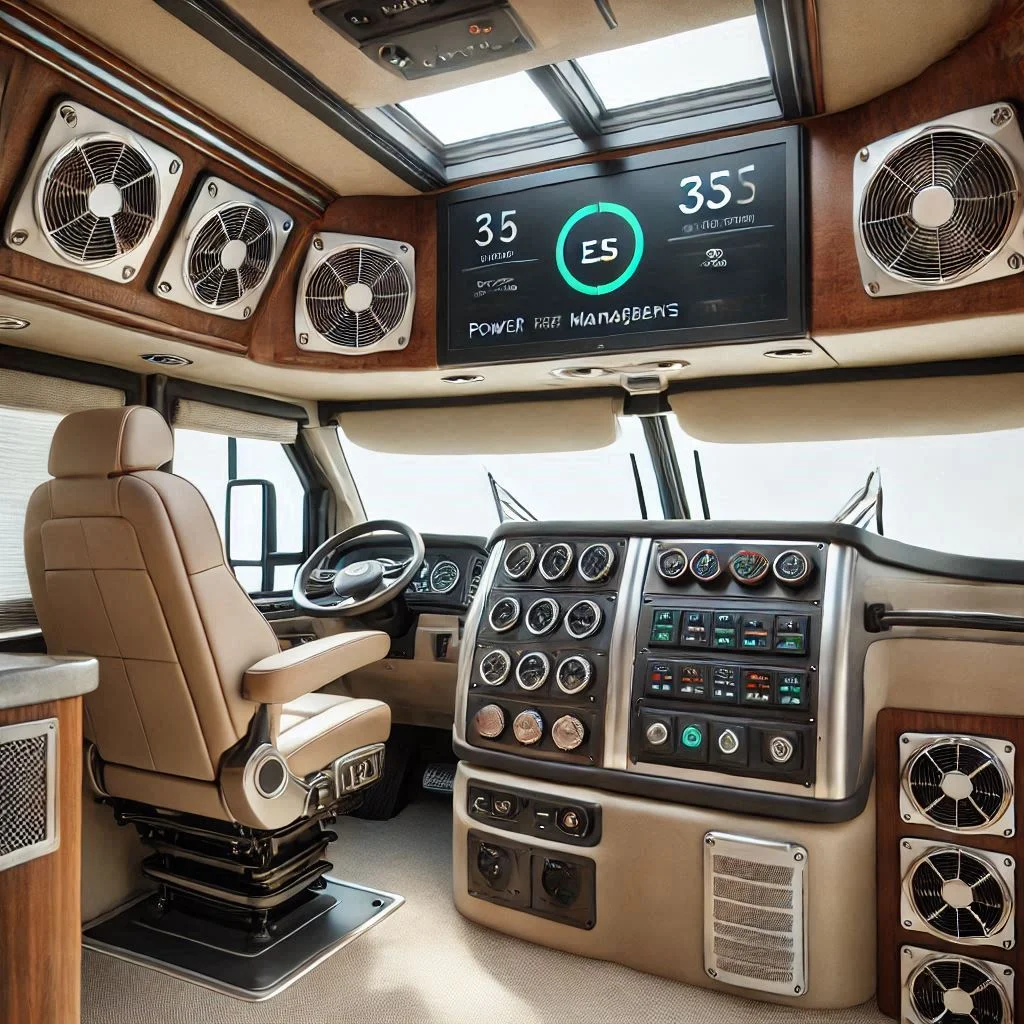
Q3: Is it safe to run an RV air conditioner while driving?
A3: Running an RV air conditioner while driving is generally safe as long as you adhere to safety guidelines. First, ensure your generator is specifically designed for use while driving and does not interfere with vehicle operation. Keep the AC system maintained and in good condition. It’s also important to monitor the fuel level in your generator, as running the air conditioner for extended periods may increase power consumption.
Q4: Can I run my RV air conditioner on a 30-amp or 15-amp power connection?
A4: Yes, you can run an RV air conditioner on a 30-amp power connection, which is the standard for most RVs. However, running an RV air conditioner on a 15-amp connection may not provide sufficient power, especially if other appliances are also in use. It’s recommended to use a 30-amp or higher connection to ensure optimal performance and prevent the system from overloading.

Q5: Can I use my RV air conditioner on 120V power?
A5: Yes, you can use your RV air conditioner on 120V power if your RV’s electrical system supports it. This is a common setup for many RVs with air conditioners. However, it’s important to ensure that your power source can handle the load, as air conditioners consume significant electricity. Be mindful of other appliances that may be running simultaneously, as they could draw too much power and cause overloads.
Q6: How can I stay cool in my RV without using the rooftop air conditioner while driving?
A6: If you prefer not to use the rooftop air conditioner while driving, there are several alternatives to stay cool:
- Battery-Powered Fans: These are portable and can circulate air inside the RV, helping to maintain comfort.
- Window Tinting and Covers: Blocking sunlight through tinted windows or using window covers will help reduce the internal temperature.
- Open Windows: Allowing fresh air to flow through the RV can naturally cool down the space.
- Portable AC Unit: These units can be a good backup if you need additional cooling without relying on the rooftop AC.

Q7: How long can you run an RV air conditioner?
A7: You can run an RV air conditioner as long as the power source allows, but extended use may put a strain on your generator or battery. Most RV air conditioners are designed for continuous use, but you should monitor fuel or battery levels to avoid unexpected shutdowns. Regular maintenance of both the air conditioner and the power source will ensure prolonged performance.
Q8: What is the smallest RV air conditioner?
A8: The smallest RV air conditioners typically have a cooling capacity ranging from 5,000 to 8,000 BTUs. These compact units are ideal for smaller RVs or for situations where less cooling power is required. They are energy-efficient and can be powered by smaller power sources, making them suitable for off-grid RVing.
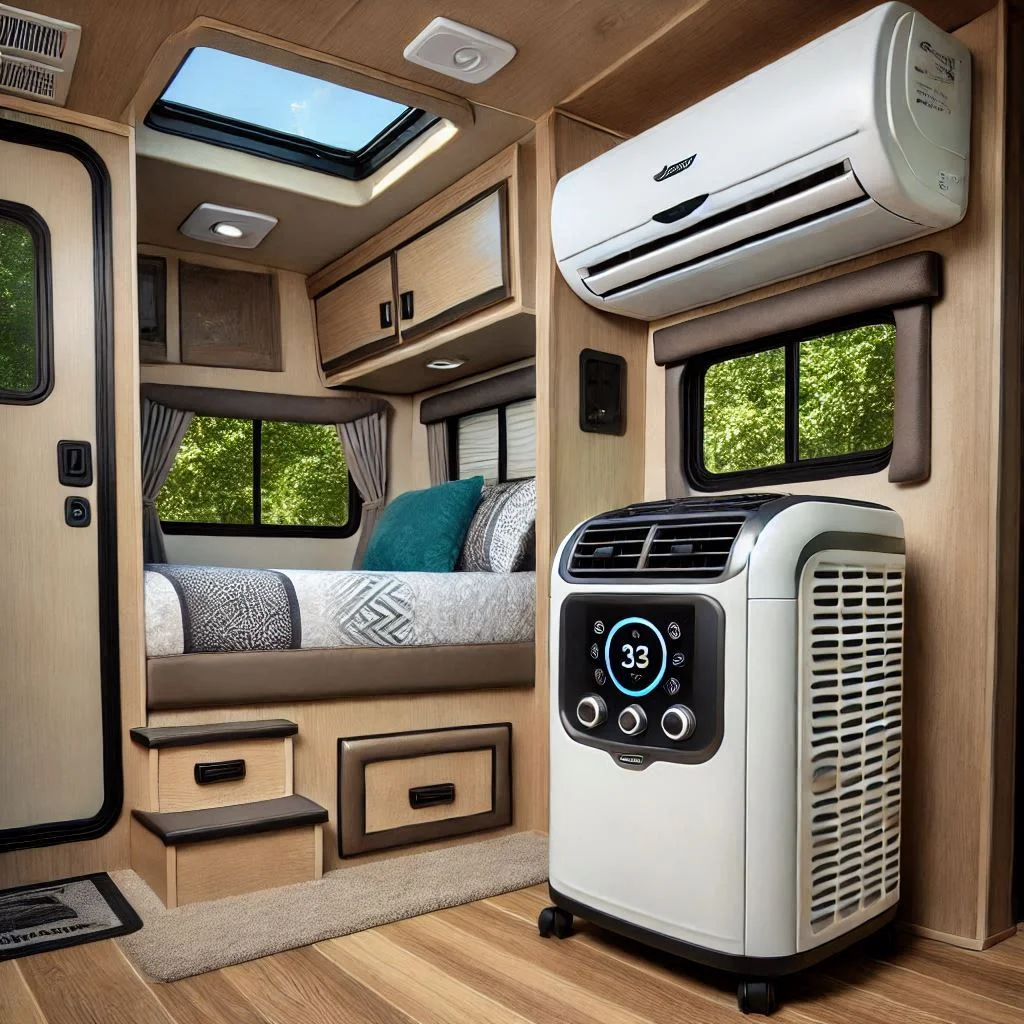
Q9: Can you add a thermostat to an RV air conditioner?
A9: Yes, you can add a thermostat to an RV air conditioner. Adding a thermostat allows for automatic temperature control, enabling the air conditioner to turn on or off based on the set temperature. This not only enhances comfort but also helps improve energy efficiency by preventing the air conditioner from running unnecessarily.
Q10: Does RV height include the air conditioner?
A10: Yes, the height of your RV includes the rooftop air conditioner. When measuring your RV’s total height for clearance purposes, whether it’s for parking or driving under overpasses, you must account for the air conditioner on the roof. Always check the total height to avoid accidents or damage when navigating low-clearance areas.
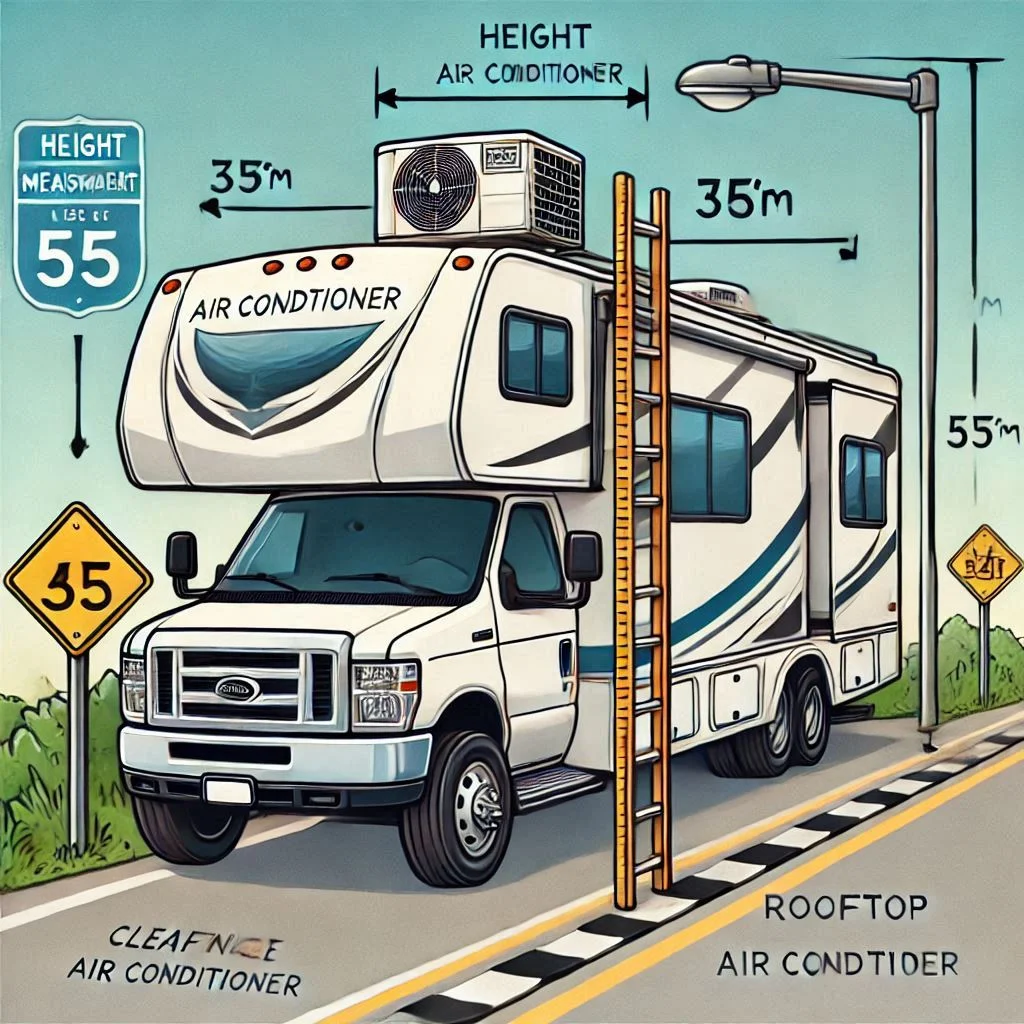
Conclusion
In conclusion, running an RV air conditioner while driving is a feasible option for staying cool on the road, but it requires understanding the power sources and safety measures involved. Whether you’re relying on a generator for your rooftop AC or using your dashboard air conditioning, it’s important to ensure that your systems are properly maintained and that you’re mindful of power usage. Additionally, exploring alternative cooling methods, such as portable fans or window covers, can offer extra comfort without overloading your power supply. By following these guidelines and addressing key questions about RV air conditioners, you can make the most of your travels while enjoying a comfortable and safe journey. Always stay informed and plan ahead to ensure a smooth and enjoyable RV experience, no matter where the road leads.

